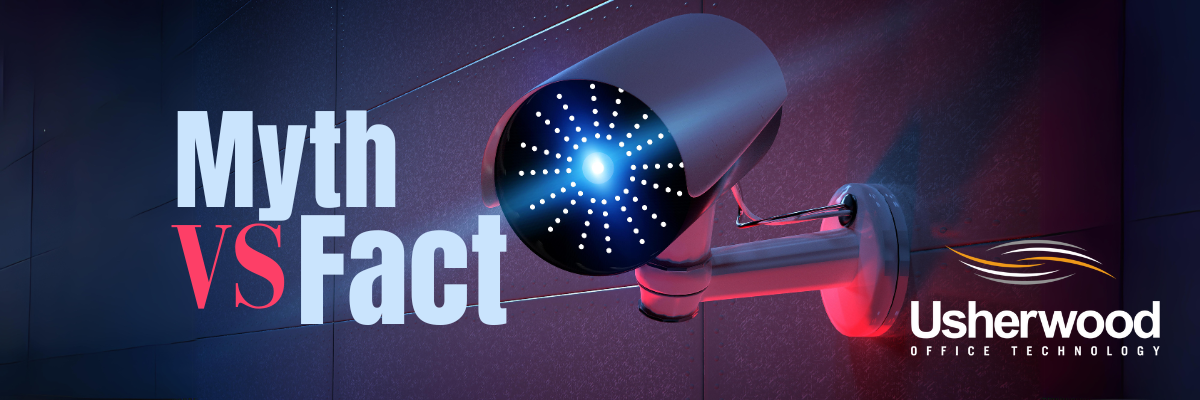By: Jada Sterling, Digital Content Manager on December 19th, 2023
5 Myths About Business Security Camera Systems
There are many commonly held beliefs about commercial security cameras. These may be due to misinformation on the internet or incorrect assumptions about certain features.
You may have even been led astray by vague or deceiving marketing verbiage about these products. We’re here to dispel the myths surrounding security cameras once and for all. Here are the top five myths you shouldn’t believe about security cameras for businesses.
Myth #1: Cameras Should Be Hidden & Hard to Spot
You might be surprised to learn that cameras don’t need to be concealed. The idea that cameras must be out of sight is a myth. In fact, they can actually act as an effective deterrent to theft and other malicious activity.
Think about department stores. They will go so far as to install monitors where shoppers can see themselves, especially in high-theft areas like makeup sections. This is a strategic way to scare shoppers away from stealing, so they move on to easier targets. For this reason, it’s not only okay to have visible cameras, they can even serve as a psychological method of theft prevention.
Myth #2: Higher Resolution= Better Image Quality
You might think that resolution specs will determine the best business security cameras. This is not true. Resolution is just a small piece to the puzzle, as a megapixel count won’t necessarily make for better image quality.
However, there are several innovative features to enhance quality to create more contrasting, colorful, and accurate picture quality. This tech can improve images for better footage, so ask your MSSP about it. This way, you won’t be fooled by any verbiage that might misrepresent camera quality.
Myth #3: You Need 24/7 Surveillance Footage
Having a camera system that doesn't record all the time may seem counterproductive, but it actually improves efficiency. Recording all the time would mean storing a large amount of footage, which can be a waste of resources. It would be difficult to search through hours of footage if you only need to find one specific event. Because of this, motion sensing technology is your best bet.
With motion detection, you can capture action without wasting time on static footage. Using your business camera security system efficiently doesn’t mean turning devices off at night or during slow hours. Rather, it means you should let the camera system decide when to record based on movement within the frame. This will decrease the amount of video to go through in investigations, effectively record suspicious activity, and save storage.
Myth #4: Wireless Security Cameras
With all the wireless devices on the market that are said to be easier to use, this does not apply to security cameras. It’s a myth that wireless security cameras are actually wireless, which they are most likely not. Wireless security cameras for business settings still need power, so they won’t be completely wire-free.
The best of both worlds would be a “power over ethernet” or PoE camera system. This is installed with one cable that can transmit both power and data efficiently. This will be both easy to install and simple to manage.
Myth #5: All Security Cameras Serve the Same Purpose
A common idea amongst people looking for business security camera systems is that all cameras work for all situations. The truth is, not all cameras are created equal terms of their capabilities.
Cameras are tools, and you should use the right tool for the right job. For example, a camera for your business’ front door won’t be the same as the one for your parking lot. Cameras has all different features including:
Weather resistance
Outdoor cameras need to be resistant to the elements. Cameras must be able to handle bad weather conditions like rain, snow, wind, and ice, depending on where your business is. You require strong cameras for outdoor use to prevent them from getting damaged or destroyed by the first storm. A local MSSP can help you choose weather-resistant options that are made for the elements in your area.
Physical Capabilities
Devices can have different numbers of cameras encased in one, also referred to as dual- or quad sensor security devices. Opting for this type of device allows you to point at multiple doors or areas at once. In turn, this can save storage, bandwidth, licensing, costs, and installation hassle by having one device do the work of as many as four cameras.
Light sensitivity
Some cameras need to record dark or bright scenes, which can affect image quality. Glares, low lighting, and other factors can make it difficult for certain cameras to capture quality footage, so these are important specs to consider.
Frame rate
The frame rate is a major element in footage accuracy. If you need to capture exactly how and when something happened, such as a split-second theft in a supermarket, you’ll need a higher frame rate.
Motion sensitivity features
As previously mentioned, motion sensitivity is an important factor for efficient surveillance. Not all cameras are designed for the same environments, and some will need more consistent footage than others. A camera aimed at a cashier may be triggered more often than one aimed at a dumpster behind the building.
This means you won’t necessarily need the same motion-activated recording in all places. For this reason, ask your MSSP about their recommendations based on the environments you’ll be monitoring.
Tamper Proofing
As you might expect, surveillance cameras are at times subject to tampering or vandalism. This will affect where they are placed, but sometimes it is unavoidable to install cameras within reach of vandals. This creates the need for tamper-proof devices. Camera systems that are within reach should be secure, durable and not easily blocked or removed.
For example, dome cameras are ideal for lower-hanging locations, since they are not as delicate as bullet cameras.
IK Ratings on Security Cameras
One measurement of what kind of impact security cameras can withstand. The IK rating measures both resistance to vandalism and unintentional impact caused by the environment. Environmental damage could occur due to flying debris from wind, falling ice, and other accidental factors.
Dome cameras tend to have IK ratings of IK08 or IK10 due to their durability and resistance to these things.
These features along with many others will vary based on where you need to place cameras. Other factors to consider when choosing security cameras would be what type of business you have, foot traffic in areas you need surveillance and other factors that your managed security service provider(MSSP) will assess.
How To Select a Security Camera System For Your Business
Don’t go in alone when selecting a business security system. It’s a big mistake to opt for a consumer-grade camera system. Although there are cheap cameras on the market, you could be wasting your money on a camera that won’t hold up when something happens.
Nothing is worse than being in the dark when you need crucial evidence, and the footage is missing or poor quality. Avoid this by partnering with an experienced security and access control provider. A quality managed security service provider (MSSP) will help you select, install, and troubleshoot your system to get the most out of it.
If you’re ready to enhance your business’s security systems, get started with a tech evaluation via the link below to speak with a security expert.
Read On

$5 Million Incentive Proposed For Retail Security Camera Systems in NYS
New York State Governor Kathy Hochul recently proposed an allotted $5 million in tax credits to...

Is Your Business’ Security Camera Footage Easy to Access?
If you are already protecting your small business with security cameras, you may be surprised to...

Best Security Camera Systems for Schools in 2025
If you're looking to replace or revamp your school's security cameras, you might feel buried by...




